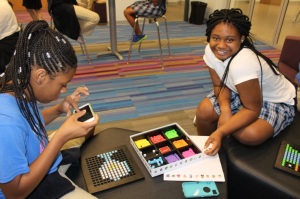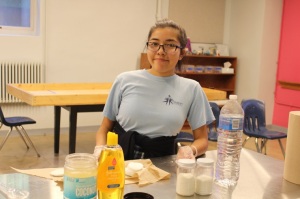Month: January 2019
Girls Quest for STEM
There are a many gatekeepers in this world, barring women from careers, hobbies, and involvement in popular culture. And this year is, for many reasons, been called the year of the woman. So, what better time to focus on getting our girls plugged into fields of interest that have been traditionally closed off to them by these arbitrary, and mostly unwritten, rules. This is what the Quest/STEM program at Marian Middle School is all about. Marian Middle School is an all girls school, so what better place to put this pilot program into practice.
Their stated goal. 
In order to understand what they have accomplished, we need to understand what their stated goal was when conceiving the program. The goal was to get Marian girls to be workforce ready critical thinkers, creative problem solvers with the skills to be highly employable in STEM careers. But even simple goals often require multi-pronged approaches as there is no one avenue into the myriad of career possibilities in the STEM field.
What did they accomplish?
Broken down into a three-pronged approach, the educators focused on the following:
- Learning through project- and inquiry-based learning and the Engineering Design Process
- “Through their STEM Quest classes this year, students were given a choice in the projects they wanted to take on based on their interests and passions. Some projects that were undertaken included rebuilding two motorized scooters, creating original video games, developing animal-friendly beauty products, designing a school prayer garden, and building a virtual school tour for the school’s website, among other projects. All projects were real-world tasks requiring students to research, plan, design, build, and evaluate. They applied learning from their traditional courses to create original work. Working with peers through the design process challenged students to think creatively, to work collaboratively, and to continuously evaluate their work to improve their product. Though it can be difficult for adults and middle school students alike, through this process Marian students are building a myriad of skills that make them highly employable for internships, positions, and opportunities available to them at their age and on which they can grow in the future.”

- Increasing interest in STEM careers
- By using a simple survey to collect data from students regarding their top three career interests they were able to categorize these careers, identifying those with a STEM focus. Year after year, comparisons are made and trend lines are established as each class moves from fifth grade through eighth grade. Students who named a STEM related career in one of their top career choices this school year include:
- 13/15 5th graders (87%)
- 15/17 6th graders (88%)
- 16/17 7th graders (94%)
- 17/17 8th graders (100%)
- Overall Total – 92%
- Through their STEM classes and Marian programming, they have been exposed to professional careers they may not have previously considered. As a result, the range of occupational interest’s students are considering for their futures is as impressive as it is diverse. Careers of interest from the survey include music producer, veterinarian, architect, marine biologist, computer engineer, paramedic, farmer, pediatrician, plastic surgeon, photographer, zoologist, neurosurgeon, cardiac surgeon, entrepreneur, obstetrician/gynecologist, film editor, forensic psychologist, federal agent nuclearmaterial courier, nurse, and occupational therapist, among others!
- Making statistically significant gains on STEM areas of standardized tests.
- Marian students took the Iowa Test of Basic Skills in September 2017 which includes Science and Math components. Seventy two percent of eighth grade students made significant gains in math and 67% made significant gains in science as compared to previous scores. The small sample size makes 1 or 2 outliers significant. All sixth and seventh graders made significant gains in math. Science averages of our student body increased in 5 of the 6 domains tested. Student averages in 4 of the 6 domains are now above the national average as compared to only 1 above the national average last year.
- By using a simple survey to collect data from students regarding their top three career interests they were able to categorize these careers, identifying those with a STEM focus. Year after year, comparisons are made and trend lines are established as each class moves from fifth grade through eighth grade. Students who named a STEM related career in one of their top career choices this school year include:
A couple of exciting projects.
One of the more exciting projects is the Prayer Garden. Students performed research on prayer gardens, as well as a number of other themed types. By assessing the needs and space available to them they were able to identify the elements they would propose. After a presentation, complete with visual aids, to the principal they were given the go ahead to purchase supplies and begin construction.
The other project is the Animal-Friendly Beauty Products. By researching practices that impact animals and products that already exist they planned, budgeted, purchased and actually made some products including animal-friendly nail cuticle oil.
In order to evaluate the success of the products, they created a survey that was distributed with the products to solicit feedback They subsequently revamped their products based on feedback for redistribution.
Not only that, but 19 Marian Girls competed in the Clavius Project Robotics Jamboree at St. Louis University High School in January. Out of 27 participating schools, Marian students won the first-place platinum award, and on top of that, were also awarded the Leadership with Distinction Award for their evident teamwork, persistence, and problem-solving skills. And an even more unique feather for this projects cap: An article was written on the National Nuclear Security Administration website about one of their 7th grade student’s curiosity in becoming a Nuclear Material Courier! This is a testament to the students’ increased interest in many different STEM related careers!
What are some of the challenges they faced?
As exciting and successful as this project has been – it is not without challenges. They’ve tried to be proactive about revising the programming and goals based on student interest, progress, and feedback. One difficulty they faced was the length of time students needed to complete a project and how difficult it is to determine at the outset. They plan to figure out how to include more flexibility in scheduling. Additionally, timing is important in the optimal utilization of workshop space and sharing of available technology to meet everyone’s needs. Ideally, they could more regularly engage community experts in STEM fields as mentors, facilitators and/or instructors for the students. However, school hours are also work hours, which makes optimal engagement difficult.
These challenges aside, they have made great strides in accomplishing their goals and we at the McCarthy Dressman Education Foundation are excited to see how this project progresses.
Further Reading
· Girls in STEM: Answering the Call for STEM Skills in Our Global Workforce
· 10 Ways to Prepare Our Daughters for STEM Careers | NetApp Blog
· Preparing K-12 Students for Future STEM Careers – The Tech Edvocate
· Starting Early: How to Address the Lack of Female Engagement in STEM at School

